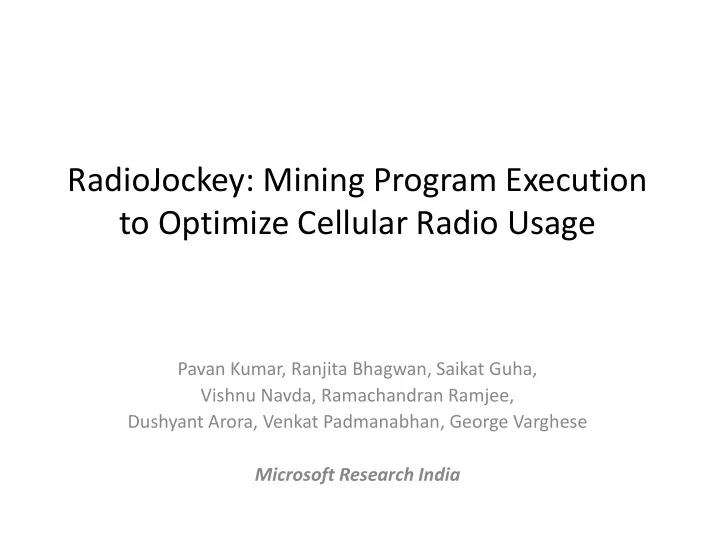

RadioJockey: Mining Program Execution to Optimize Cellular Radio Usage Pavan Kumar, Ranjita Bhagwan, Saikat Guha, Vishnu Navda, Ramachandran Ramjee, Dushyant Arora, Venkat Padmanabhan, George Varghese Microsoft Research India
Problem Context: Overheads in Cellular Radio Usage Wakeup Tx/Rx Tx/Rx State transitions based on: (1) traffic volume CELL_DCH CELL_FACH IDLE (2) operator chosen timers Timeout T1 Timeout T2 Signaling Power Consumption Transition # control 350 T2 Avg Current in mA T1 messages Tx/Rx 300 IDLE DCH 30 250 DCH IDLE 200 2 150 Radio Tail Latency (15-20J) 100 Transition Secs 50 IDLE IDLE Ramp-up IDLE DCH 2 0 0 5 10 15 20 25 30 DCH IDLE 20 2 Time in Seconds
Existing Radio-tail Optimizations 1. Amortize tail overhead by shaping traffic time a) TailEnder [IMC 09] prefetching batching 2. Adapt tail using Fast-dormancy a) Based on application hints – TOP [ICNP 10] b) Based on client-side idle timers – Falaki et al. [IMC 10]
Existing Radio-tail Optimizations 1. Amortize tail overhead by shaping traffic time a) TailEnder [IMC 09] prefetching batching Requires app changes 2. Adapt tail using Fast-dormancy a) Based on application hints – Requires app changes + TOP [ICNP 10] developer awareness b) Based on client-side idle timers – Falaki et al. [IMC 10] Commonly used in many smartphones (3-5 sec timers)
Fast Dormancy Woes Disproportionate increase in signaling traffic caused due to increase in use of fast-dormancy “Apple upset several operators last year when it implemented firmware 3.0 on the iPhone with a fast dormancy feature that prematurely requested a network release only to follow on with a request to connect back to the network or by a request to re-establish a connection with the network …” What's really causing the capacity crunch? - FierceWireless
Problem #1: Chatty Background Apps CDF of inter-packet times for Outlook application running in background • No distinctive knee • High mispredictions for fixed inactivity timer
Problem #2: Varying Network Conditions CDF of inter-packet times for Lync application for different network conditions • Signal quality variations and handoffs cause sudden latency spikes • Aggressive timers frequently misfire
Objectives • Design a fast-dormancy policy for long- standing background apps which – Achieves energy savings – Without increasing signaling overhead – Without requiring app modifications
When to Invoke Fast Dormancy? fast dormancy Packets within End of session - EOS session ≥ 𝑢 𝑡 App traffic time Energy DCH DCH DCH Profile IDLE Example 1 Example 2 Energy savings when 𝑢 𝑡 ≥ 3 𝑡𝑓𝑑 and fast dormancy is invoked immediately after end of session
Problem: predict end of session (or onset of network inactivity) Idea: exploit unique application characteristics (if any) at end of sessions Typical operations performed: • UI element update • Memory allocation or cleanup • Processing received data System calls invoked by an app can provide insights into the operations being performed
Predicting onset of network inactivity • Technique: Supervised learning using C5.0 decision trees • Data item: system calls observed immediately after a packet (encoded as bit-vector) • Label: ACTIVE or EOS EOS ACTIVE EOS data-item data-item data-item 𝑢 𝑥 𝑢 𝑥 𝑢 𝑥 WaitForSingleObjectEx ( ) DispatchMessageW ( ) ReleaseMutex ( ) CloseHandle( ) CloseHandle( ) FreeLibrary( ) FreeLibrary( ) System call trace …( ) …( ) …( ) …( ) …( ) …( ) Time > 𝑢 𝑡 Network secs traffic P1 P2 P3 Packets in packet in session 2 Session 1
Decision tree example Application: gnotify DispatchMessage 1 0 ACTIVE send 0 1 EOS ACTIVE Rules: (DispatchMessage & ! send) => EOS ! DispathcMessage => ACTIVE (DispatchMessage & send) => ACTIVE
RadioJockey System Offline learning App 1 Rules App k Rules System Calls Training + traces using C5.0 Network Traffic Runtime Engine App System Calls Tree- + matching Packet timestamps (run-time) Fast Dormancy Cellular Radio Interface 13
Evaluation Overview 1. Trace driven simulations on traces from 14 applications (Windows and Android platform) on 3G network – Feature set evaluation for training – variable workloads and network characteristics – 20-40% energy savings and 1-4% increase in signaling over 3 sec idle timer 2. Runtime evaluation on 3 concurrent background applications on Windows
Energy drain and signaling overhead Energy consumed normalized to a 3-second idle timer approach Signaling overhead normalized to a 3-second idle timer approach
Runtime Evaluation with Concurrent Background Applications • 22-24% energy savings at a cost of 4-7 % signaling overhead • Marginal increase in signaling due to variance in packet timestamps
Summary • RadioJockey predicts onset of network inactivity using system calls invoked by background apps • Requires no modifications to existing apps – legacy, native and managed apps • Achieves energy savings of 20-40% with marginal increase in signaling overhead
Backup Slides
Predict using only network features • Features : IP, ports, TCP flags, HTTP headers • Performance: – Energy savings only for simple apps – No good rules for complex apps(Outlook and Lync) – Cannot handle apps that use encryption
Varying networks and workloads Energy consumed normalized to a 3-second idle timer approach
Feature Space Exploration and Choice of Window Size • PrevState feature captures temporal state information • Adding PrevState into learning boosted savings • 𝑢 𝑥 of 0.5 seconds sufficient for most applications
Understanding Fast Dormancy Feature • Client controlled • Tail energy reduced to ~1.5J • Without network support – RRC connection torn down – DCH/FACH to IDLE – Ramp-up costs up to 30 msgs • With network support – Ramp-down to PCH instead of IDLE – Ramp-up to DCH incurs 12 msgs
Recommend
More recommend